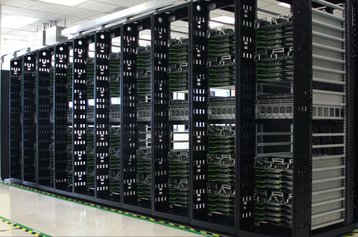The connection between railway switching and data centers may seem unlikely for most, but many point to the width of a train car as a major influencer of IT racks’ and enclosures’ dimensions. By tracing their origins to deployments in railway signaling, many people believe the 19-inch equipment bay was chosen because the rack could fit within a train car. Since the initial decision to have a 19-inch equipment bay was made, it has not changed for almost a century. Over the years, components within racks, such as switches, storage, servers, all needed to fit into the 19-inch equipment bay. Thus, the racks dictated the designs.
To understand how illogical this was to some pioneers of open infrastructure designs, imagine if the designers of smartphone cases set the standards for the dimensions for all smartphones. Whatever the initial decision about the case dimensions was, the phone dimensions must match. Although purposefully more absurd in this example, it is clear why this design practice is viewed as outrageous by many. Partly as a response to the perceived irrational practice, companies with large data center footprints began to look at other architectures.
Another cause of the open infrastructure design movement is customers viewing the markup on data center products as unfair and based on unnecessary proprietary solutions. Vendors have built a lot of features into various data center products. These features allow vendors to sell their products at higher prices. For many companies with a large data center footprint, these features are unnecessary because of:
- Their software is disaggregated from their hardware causing less need for an instantaneous response to hardware failure.
- They have an in-house team of developers that can build custom management and/or monitoring solutions. As a result, large customers became unwilling to pay for these features and started demanding lower cost, more basic solutions.
Both the reliance on dimensions because of rack design and the addition of proprietary technology causing higher markup has led others to question if data centers can be more efficient with other infrastructure designs. Many creators of these designs believe they can lower their data centers’ capital expenses be demanding lower cost solutions. Additionally, they believe they can reduce their operational expenses by designing more efficient solutions.
Trends led by open infrastructure architectures vendors can leverage:
Fear of commoditization and replacement
For many traditional vendors, the market’s move to open infrastructure architecture is frightening. Many vendors see the move to open infrastructure as a driving force of the commoditization of infrastructure components. They fear customers seeking open products will only buy the cheapest IT racks or stop using products like rPDUs. However, this fear has not materialized. Although many customers are excited about open infrastructure because it will bring cheaper solutions, IHS Markit found these products to be priced lower only about 50 percent of the time.
Because of the higher dynamic load ratings necessary for the fully integrated rack deployments, many open racks are more expensive than their traditional counterparts. Additionally, even though Facebook has shown the benefits of using newer rack-level power distribution techniques via new products, like the power shelf and busbars, many customers are still relying on more traditional rack-level power distribution methods, like rPDUs. Many vendors assume this is because of the cautious attitudes of data center operators. However, it is important to note that the buying power of hyperscalers (who often purchase open infrastructure) is driving the price of data center infrastructure components down; and this would happen regardless of the open infrastructure movement.
Liminal products
Another trend traditional vendors may be able to capitalize on is increased interest in liminal products. These are products that can be used in both traditional and open infrastructure designs. For example, one specification of Project Olympus is a universal PDU by Geist that allows a single SKU to be used in any data center around the world, regardless of different standard voltage. Not only is Microsoft interested in this universal PDU, but customers with globally diverse data center locations and traditional infrastructure are also interested in this product. In addition to the UPDU, there have been products, like rail kits, that work with both 21-inch and 19-inch racks.
Customization
The open infrastructure movement frustrates many vendors with its promise of new standards, but a continual reliance on custom designs. Many customers with large data centers are very interested in the open infrastructure movement but do not want the same design as other customers. They want a specific design, which their internal team has deemed the best, most efficient design. For vendors, this means each new design needs a new custom solution to meet their customer demands. For many, open infrastructure designs are no different from other custom projects.
The rise in custom products also means that many smaller customers cannot take advantage of the open infrastructure movement unless they want the exact same specifications as a large customer because most vendors have a minimum order quantity. This trend towards customization may not reach the majority of the enterprises if Open19’s standard proves to be a highly efficient and scalable solution, making Open19 an important standard to watch.
More integration
Another trend vendors are seeing in tangent with the rise of open infrastructure requests is more customers requesting full rack integration before deploying the rack in the data center. For many rack vendors, this means strengthening relationships with IT equipment vendors and system integrators, companies that fully install and test all the IT equipment before deploying it.
For IT hardware companies, this means ensuring that the equipment’s warranty is not voided via the shipment of IT equipment installed in the rack. For system integrators, it is important for vendors to be able to supply infrastructure pieces quickly to the system integrator, so they can meet the changing demands of their customers. For many vendors, this means keeping inventory near or at the system integrators. The move to full integration of the racks before deployment means the new level of compute is a rack and no longer a server.
Bottom line
Even if open infrastructure is not poised to take over the market soon, it is already shifting the relationship between vendors and customers. Now, vendors not only need to be sellers of data center infrastructure products, but they also need to provide customers with service and support to implement the best solutions (and/or have a relationship with a system integrator or other third party). These new expectations give vendors an important opportunity to strengthen their relationship with existing customers and learn about emerging needs of the industry.


